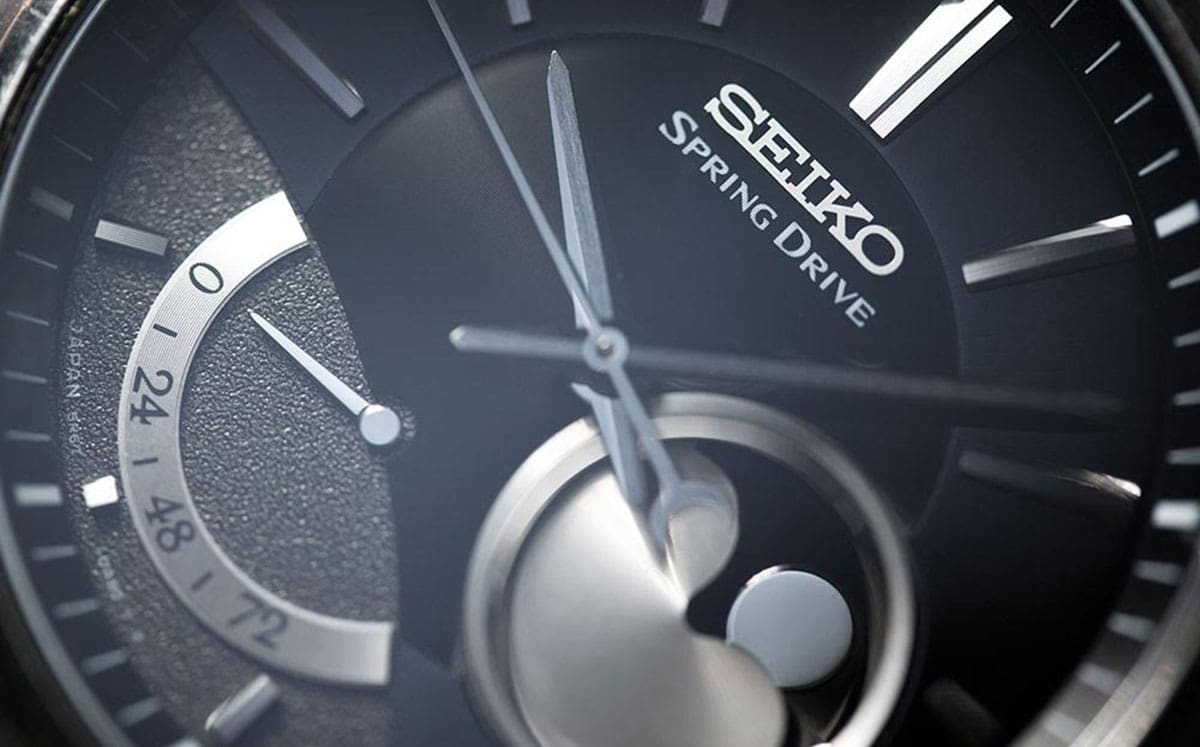With the caveat that no single patent application indicates a future product, here are my prognostications on the future technological path of Spring Drive, with explanations based on both Seiko patent filings and my reading of the 2025 watch market.
![Image]()
(from Akio Naito presentation during W&W 2025)
1. SD has always been a response to customer needs, as expressed by market forces
By the middle of the 80s, the broad strokes of motor-driven quartz had been sketched out. Accuracy had been tamed, first with analog thermocompensation (TC) to better than a minute a year, then with Twin Quartz, then in-IC TC.
Functionality was unlimited by the use of either digital displays (Seiko LC) or multiple motors (7A28) or both.
Miniaturization, which is the converse of functionality, was a matter of time (and Moore's law) as the 1.6 mm thin HAQ 8N41 proved.
The last frontier was customer convenience. Mid-80s quartz watches came with the major inconvenience of battery changes. It did not help that the fashion was thin and small, which meant the 16-fold efficiency improvement since the 70s was 'wasted' on having to fit a 1/4th sized battery.
(Another inconvenience was the non-perpetual calendar, but this was only 5 times a year with the benefit to the crown gasket of a little movement.)
To that generation of engineers, solar cells and rechargeable batteries had unknown longevity, while the mainspring was proven as energy storage, if it could be harnessed.
Spring Drive as envisioned by Yoshikazu Akahane and his colleagues was a solution to the inconvenience of the chemical battery. While of course being also chronometrically respectable in the context of the late 70s, i.e. matching ordinary quartz at +/-15 s/month.
But would the customer accept a large watch after being accustomed to slim models? No one knew, and the size of early SD prototypes didn't help.
Seiko therefore first tried another approach: the 1988 A.G.S. These movements fit expectations of the time at 27.6 mm diameter. Those first batteries were good for 75 hours runtime. When new.
Improved and marketed as 'Kinetic' in 1997, one can appreciate how long Seiko pursued this approach to the battery replacement problem. (Far longer than Swatch Group with its 'autoquartz'.)
![Image]()
2. Market changes made SD not just technologically but also commercially feasible
By the mid-90s, marked by the Royal Oak Offshore 'Beast' in 1993, it was clear to any market researcher that thin wasn't as important at the upper reaches of the market as it was in the 80s. Watch enthusiasts wanted to wear a substantial-feeling and substantial-looking wristwatch.
The market portal had therefore opened to industrialize SD, first as the cal. 7R in 1999, then as the hefty automatic 9R65 in 2004.
Here was a quartz-accurate wristwatch, with automatic winding and power reserve sufficient for a weekend off the wrist.
The steel SBGA001/003 were 39 mm and quite thick for a quartz, but that was ok, or even a good thing.
Grand Seiko had relaunched with motor-drive quartz in 1993, then 9S automatic in 1998, and even a GMT in 2002. Finally, a synthesis of both.
9R6 would be the flagship for the next 16 years. 9R66 GMT followed close behind in 2006 and the mighty 9R86 chronograph GMT just a year later.
9R was naturally the engine inside the largest GS cases, debuting as 2016's SBGE037/039 and SBGC015/017. But that was near Peak Big Watch, viewed in hindsight, so those 46 mm models did not become the norm for high end GS sport watches.
![Image]()
3. Market changes again after 2016.
At some point, the main selling point of Spring Drive became no longer the accuracy, but rather its perfectly smooth sweep of the hands. This included the chronograph, which is the only wrist chronograph with infinite resolution in the world.
The dial also gained prominence, and with it the negative reactions to the dial-side PR hand. Model nicknames like 'Snowflake' or 'Tatami' predominantly referred to the dial (not case or dial furniture) of the watch.
In all of these, customer needs were changing. The movement per se mattered less to the 2010's customer. The 'mechanical purists' were being outnumbered by those enjoyed the visual beauty of the watch in motion.
Not how the machine inside functioned to move the hands, but how the hands moved. That's why the old customers generally accepted the PR dial, but many new customers objected.
The new focus on watch appearance (vs movement geekery) is why unique dials have become such a GS selling point, an advantage skillfully used by GS to also sell many SBGH and SBGJ models to collectors.
![Image]()
The long-term implications of this change for Spring Drive will be discussed in post #2.
1. SD has always been a response to customer needs, as expressed by market forces
By the middle of the 80s, the broad strokes of motor-driven quartz had been sketched out. Accuracy had been tamed, first with analog thermocompensation (TC) to better than a minute a year, then with Twin Quartz, then in-IC TC.
Functionality was unlimited by the use of either digital displays (Seiko LC) or multiple motors (7A28) or both.
Miniaturization, which is the converse of functionality, was a matter of time (and Moore's law) as the 1.6 mm thin HAQ 8N41 proved.
The last frontier was customer convenience. Mid-80s quartz watches came with the major inconvenience of battery changes. It did not help that the fashion was thin and small, which meant the 16-fold efficiency improvement since the 70s was 'wasted' on having to fit a 1/4th sized battery.
(Another inconvenience was the non-perpetual calendar, but this was only 5 times a year with the benefit to the crown gasket of a little movement.)
To that generation of engineers, solar cells and rechargeable batteries had unknown longevity, while the mainspring was proven as energy storage, if it could be harnessed.
Spring Drive as envisioned by Yoshikazu Akahane and his colleagues was a solution to the inconvenience of the chemical battery. While of course being also chronometrically respectable in the context of the late 70s, i.e. matching ordinary quartz at +/-15 s/month.
But would the customer accept a large watch after being accustomed to slim models? No one knew, and the size of early SD prototypes didn't help.
Seiko therefore first tried another approach: the 1988 A.G.S. These movements fit expectations of the time at 27.6 mm diameter. Those first batteries were good for 75 hours runtime. When new.
Improved and marketed as 'Kinetic' in 1997, one can appreciate how long Seiko pursued this approach to the battery replacement problem. (Far longer than Swatch Group with its 'autoquartz'.)
2. Market changes made SD not just technologically but also commercially feasible
By the mid-90s, marked by the Royal Oak Offshore 'Beast' in 1993, it was clear to any market researcher that thin wasn't as important at the upper reaches of the market as it was in the 80s. Watch enthusiasts wanted to wear a substantial-feeling and substantial-looking wristwatch.
The market portal had therefore opened to industrialize SD, first as the cal. 7R in 1999, then as the hefty automatic 9R65 in 2004.
Here was a quartz-accurate wristwatch, with automatic winding and power reserve sufficient for a weekend off the wrist.
The steel SBGA001/003 were 39 mm and quite thick for a quartz, but that was ok, or even a good thing.
Grand Seiko had relaunched with motor-drive quartz in 1993, then 9S automatic in 1998, and even a GMT in 2002. Finally, a synthesis of both.
9R6 would be the flagship for the next 16 years. 9R66 GMT followed close behind in 2006 and the mighty 9R86 chronograph GMT just a year later.
9R was naturally the engine inside the largest GS cases, debuting as 2016's SBGE037/039 and SBGC015/017. But that was near Peak Big Watch, viewed in hindsight, so those 46 mm models did not become the norm for high end GS sport watches.
3. Market changes again after 2016.
At some point, the main selling point of Spring Drive became no longer the accuracy, but rather its perfectly smooth sweep of the hands. This included the chronograph, which is the only wrist chronograph with infinite resolution in the world.
The dial also gained prominence, and with it the negative reactions to the dial-side PR hand. Model nicknames like 'Snowflake' or 'Tatami' predominantly referred to the dial (not case or dial furniture) of the watch.
In all of these, customer needs were changing. The movement per se mattered less to the 2010's customer. The 'mechanical purists' were being outnumbered by those enjoyed the visual beauty of the watch in motion.
Not how the machine inside functioned to move the hands, but how the hands moved. That's why the old customers generally accepted the PR dial, but many new customers objected.
The new focus on watch appearance (vs movement geekery) is why unique dials have become such a GS selling point, an advantage skillfully used by GS to also sell many SBGH and SBGJ models to collectors.
The long-term implications of this change for Spring Drive will be discussed in post #2.









